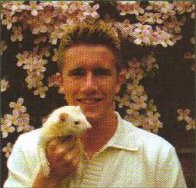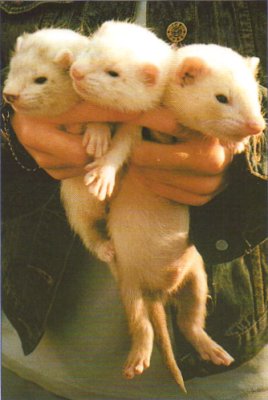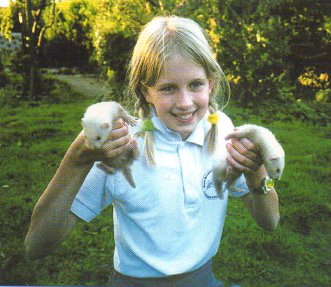Responsible Breeding Part 2
 MICHAEL SANDERSON continues his detailed look at the reponsible breeding of ferrets with the exciting moment when the kits arrive.
MICHAEL SANDERSON continues his detailed look at the reponsible breeding of ferrets with the exciting moment when the kits arrive.
 Gestation in a ferret is about 42 days. Start counting down from the day you take the jill out from the hob. More times than not your ferret will give birth on the exact day she is due although most do so at night or when it's quiet.
Gestation in a ferret is about 42 days. Start counting down from the day you take the jill out from the hob. More times than not your ferret will give birth on the exact day she is due although most do so at night or when it's quiet.
Your ferret does not need to be isolated during the whole of gestation. Just make sure she receives a correct balanced diet and it is advised that you give her a supplement. Lactol whisked with an egg yolk provides the best nutrition. There are no mixing guidelines for ferrets on the tin but here is the mix I find best: fill a large mug just under half full of boiling water. Add a level scoop of Lactol powder (a scoop is provided) and stir. Add cold water until the mug is between half and three quarters full. Add an egg yolk and whisk. Feed while still warm.
Two weeks before the kits are due it is recommended that the jill is isolated. Put her in a hutch that has been thoroughly cleaned and provide lots of fresh meadow hay. About ten days before the birth she will build a nest for the kits. Put more hay in the run area of the hutch just outside the nestbox door. She will pull this into the nest as she gradually builds it up.
At this time your jill will start to cast. She will pull her coat out herself and line the nest with it providing a soft bed for when the kits arrive. This may cause her to look rather raggy but it is normal. Once the jill is separated provide her with a regular supply of Lactol and greatly increase her food. Provide only the best. Mince, tuna and other fresh meat are all great but I also feed complete ferret food because it contains a perfect balanced diet. Beware that when your jill is pregnant she will store food away. With dry food this isn't much of a problem but make sure that meat is not stored for long periods in the nestbox as this can cause disease which could kill the vulnerable kits. Check every day.
The kits will be born deaf, blind, naked and completely dependant on their mother. Avoid constant disturbing of the litter in the first few days. With jills that know you very well and are experienced at breeding, you are normally fine to have a nosy in and keep a check on the kits. However, with strange jills or jills having their first litter you should keep off for the first week. They may well see you as a threat and kill their young by eating them. They do this because it brings them back into season so they can breed again.
Normally, the cry of the litter from the nestbox is the best indication that the kits have arrived and are OK. For these first few days it is best to restrict the amount of meat being given as you cannot keep check of storage. Keep giving the
 jill plenty of good food and Lactol as this will come through in her milk providing the kits with the best nutrition.
jill plenty of good food and Lactol as this will come through in her milk providing the kits with the best nutrition.
Development and growth of the kits is rapid. From day three a fine covering of white fur will be seen growing in. The eyes open at about 3-4 weeks, by which time the kits' size has dramatically increased and they will be walking around the hutch, normally to be dragged back into the nestbox by their mother! Right up to this time it is best to keep feeding the Lactol as the kits will be drinking it themselves ensuring healthy growth.
At six weeks old, the kits will have fully functioning eyes and ears and will be darting around everywhere. Their mother will be run of her feet so plenty of food is essential. It's safe to allow the mother a few hours away from the kits each day, either to play with her old friends or to spend some time with you. It can be risky letting the kits meet strange ferrets at this time as some adults react violently to them. The kits will now be smaller versions of their adult self and their colour will be established. Polecat kits are often totally black on the face and a mask will form over the next few weeks.
Your kits should be will handled and handling can start as early as the mother will allow it. Well handled kits shouldn't show serious aggression towards their owners but some can get carried away when playing. Any biting that is seen to be too hard should be greeted with a swift flick to the nose or the side of the face. Problems with ferrets biting as adults can mostly be traced back to when the feret was young. They may not have been handled sufficiently or were allowed to get away with too much from soft owners. None of us want to hurt our pets but there is a huge gap between being nasty and giving discipline. You want them to grow up to be good-natured happy ferrets.
Weaning usually occurs at about eight weeks but in very small litters of four or five it might occur at about seven weeks as the kits will have grown more quickly because of less competition for nutrition in and out of the womb. By this time it's best to take their mother out and give her a well deserved break. You could leave her on her own for a few days or put her back with her own friends. Keep the kits well fed but can stop giving Lactol at this point. Up until 12 weeks keep the kits together. Once they reach 12 weeks it is then safe for you to introduce them to other ferrets and to separate the litter. If you have other homes waiting for the kits then this is the time to let them go and start a new life as younger animals will adapt more quickly to a changed environment.
Raising kits is a brilliant experience. In the majority of cases you are able to watch the kits grow and develop into young adults without any problems occurring. The best thing about breeding is that you have control over the nature of the adult ferret. You can handle them into perfectly tame family pets or train them up as your ideal working partner. As your old show ferrets gradually retire to a peaceful life away from the show scene you can watch the next generation make their achievements, carrying on from their parents. Then when the time comes, you can breed from them, creating a successful line and watching the development of a new generation all over again. Sometimes it is amazing to see the characteristics of a kit reflect so accurately that of their parents. Some kits are like clones!
There are so many situations that can occur when breeding that it's impossible to detail them all here so any queries will be happily received.
For whatever reason you breed, then do so responsibly and it will be an experience you will never forget.
